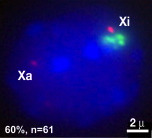Current Research in the Sun Lab investigates:
The Sun laboratory is interested in understanding how a living cell controls its genetic and epigenetic composition. The main focus of our research involves the functional roles of long noncoding RNAs (lncRNAs) in epigenetic programming. Increasing evidence from large-scale transcriptome sequencing projects suggests a high abundance of lncRNAs present in human genome and potentially significant roles of lncRNAs in various aspects of biological processes. The research projects in our lab will address the following three questions: 1) What are molecular features required for lncRNA function? 2) What are the mechanisms for lncRNA regulation? 3) How have lncRNA functions evolved?

1. Currently, we use mammalian X chromosome inactivation (XCI) as a model to investigate the specificity of lncRNAs in dosage sensing. As unique machinery achieving whole-chromosome gene silencing, XCI is predominately controlled by lncRNAs that capable of sensing chromosome numbers and tuning gene expression. Using embryonic stem cells and transgenic mice, we are interested in identifying and characterizing lncRNAs for X chromosome counting. Our research aims to capture essential features (i.e. RNA sequence and structure motifs, temporal and tissue-specific regulation, etc.) that confer lncRNA function in gene dosage control.

2. With the rapid expansion of prediction and identification of lncRNAs in stem cell reprogramming and cancer, our lab is also interested to identify disease-associated lncRNAs that involve chromosomal aneuploidies or copy-number variations (CNVs). Our research findings will contribute to a comprehensive understanding of noncoding RNA regulation and will help provide new avenues for disease therapy.
3. As “nothing in biology makes sense except in the light of evolution” (Dobzhansky 1973), we seek to address the origin and evolution of lncRNA functions using comparative sequence and functional analyses with molecular genetic tools in mouse ES cells.